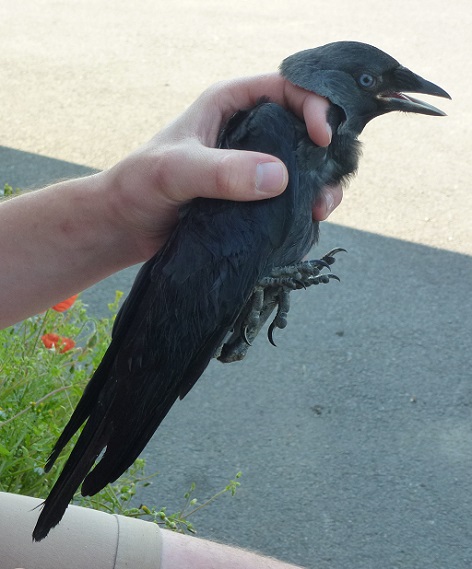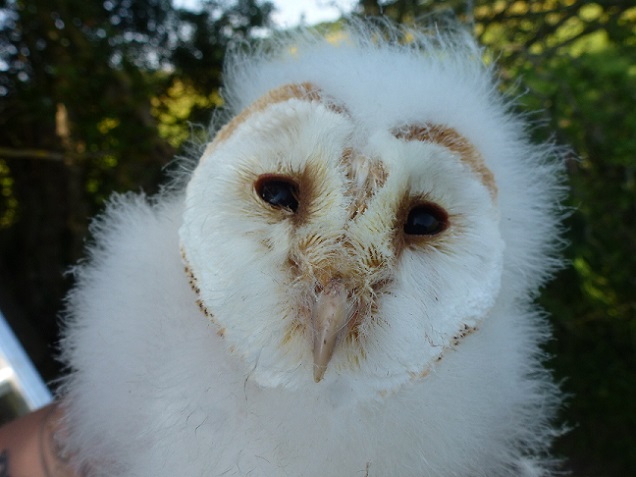After a bit of an hiatus with ringing so far this month, with just a session at Tedworth House on the 7th June, notable for ringing my first Blackbird pulli (thanks to the finding and handling skills of the estimable Jack Daw) and then eight days away walking in Scotland, I was delighted to find the weather was fine for ringing at Blakehill. I went for a bit of a recce on Saturday afternoon, only to find the place crawling with birders; including Mike Hamzij, Rob Turner and Jonny Cooper, all looking for the male Red-backed Shrike seen on Friday (and mis-reported as still being present on Saturday). Fortunately, the search had been called off before Sunday dawned. I had a team of three with me for the session, with nets set in the Whitworth and Butterfly fields, either side of the Whitworth Centre. The team was Jonny, Annie and Steph - with her daughter Lily (to supervise us). The early catch was quite slow, with only seven birds caught between 5:30 and 8:00. Between then and shutting the nets at 11:00, we caught another 40 individuals. We shut the nets at 11:00, because the nets were in full sun and it was so hot we didn't want the birds getting heat stressed whilst awaiting extraction. The team spent rather more time out in the sun, but with good reason, as outlined later.
The catch was a good one. Our first indication that it would be special was when a young Jackdaw blundered into a net. I don't know what was funnier / sadder, me trying to run to get there, with a crocked ankle, before it escaped, or Jonny, who was doing the other set of nets, quite unnecessarily sprinting across the field to find out what it was that we had caught. He got to ring it, for his efforts and enthusiasm.

Thereafter we had a really decent catch, with lots of juvenile birds, primarily from Whitethroat, Robin and Dunnock (3 each), Chiffchaff (5), Blue Tit (9) and Great Tit (7). The Great Tit youngsters were almost certainly from a single brood that had fledged that morning: they were caught in a single catch, in the same two metre stretch of net. The total list for the day was: Jackdaw 1; Blue Tit 9(1); Great Tit 7; Long-tailed Tit 2; Dunnock 4; Robin 3; Blackbird 1; Blackcap 3; Whitethroat 5; Lesser Whitethroat 2; Chiffchaff 5; Willow Warbler 1; Chaffinch 1; Goldfinch 1; Bullfinch 1; House Sparrow 1. 47 birds ringed and one retrapped from 16 species. It seems that every session at the western side of Blakehill throws up one House Sparrow to be ringed.
Once we had closed the nets the five of us went over to the A-shaped owl box to see what might be in residence:

I am delighted to say that we found, and ringed, three Barn Owl chicks. This bird was very well developed. Its siblings were not that far behind, but this one had nearly full grown primary feathers. All three were safely ringed and returned to the box. The team learned a lot from that little excursion: that owlets can projectile poo for several feet (most of it going down Jonny's arm and leg and into his Wellie boot) and that even the smallest have talons that can make a painful hole in a finger or thumb. Despite their injuries, the comments whilst we walked back to the Whitworth Centre seemed to comprise mainly of the word "amazing". Jonny and I then checked the other, old style, box between Pool Ground and Cricklade field. That one was empty, except for signs of a Jackdaw nest.
Jackdaws will nest in the most unlikely of places. In the educational play area of the Whitworth Centre is a bug hotel. It stands just about 5 feet tall and has half-a-dozen compartments. A pair of Jackdaws decided that the top left compartment would be a good place for a nest. They were correct: on a previous recce mission to the Centre, the Trust's well-being team were on-site and they mentioned that the Jackdaw young were still in the nest. As, on subsequent investigation, they were at the perfect age for ringing (flight feathers short to medium) I gave the team an impromptu ringing demonstration and added four Jackdaw pulli to my list. They have subsequently successfully fledged from the bug hotel. It will be interesting to see if they use it again next year.
During the course of the session we were treated to the sound of Curlew calling on a few occasions and then watched them flying around the fields. One seemed to be heading off, strongly, in a Purtonward direction. I know they are attempting to breed in the fields nearby to Purton but do they really travel that far to feed? Red Kite circling over the fields was also a nice sight to see. ST/JC/AH/SB/LB
